LevelOne FCS-7111 User Manual

FCS-7111
1-Port H.264 PoE Video Server
User’s Manual
V1.0

Table of Contents
Overview 3
Read Before Use 3 Package Contents 3 Physical Description 4 Network Deployment 7
Software Installation 10 Network Setting 15 PPPoE Setting 15
Accessing the Video Server 22
Using Web Browsers 22 Using RTSP Players 24 Using 3GPP-compatible Mobile Devices 25 Using LevelOne Recording Software 26
Main Page 27
Client Settings 31
Configuration 33
System |
34 |
Security |
36 |
HTTPS (Hypertext Transfer Protocol over SSL) |
37 |
SNMP (Simple Network Management Protocol) |
42 |
Network |
43 |
DDNS |
58 |
Access List |
60 |
Audio and Video |
63 |
Motion Detection |
69 |
Camera Tampering Detection |
71 |
Camera Control |
72 |
Homepage Layout |
77 |
Application |
80 |
Recording |
93 |
Local Storage |
96 |
System Log |
100 |
View Parameters |
101 |
Maintenance |
102 |
Appendix 106
URL Commands for the Network Camera/Video Server 106
2 - User's Manual

Overview
LevelOne FCS-7111 is a 1-CH video server supporting the high-performance H.264 compression format that drastically reduces file sizes and conserves valuable bandwidth and storage space. With MPEG-4 and MJPEG compatibility, video streams also can be transmitted in either of these formats for versatile applications. The streams can also be individually configured with separate frame rates, resolution, and image quality so as to meet different needs or bandwidth constraints. Users can receive multiple streams simultaneously in different settings for viewing on different platforms such as PCs or mobile phones.
The integrated 802.3af compliant PoE function reduces cabling problems, making the FCS-7111 a costeffective surveillance solution. The built-in SD/SDHC card slot offers a convenient and portable storage option to prevent data loss in case of network disconnection. Since all data can be stored on a SD/SDHC card, the on-board storage design significantly reduces bandwidth consumption.
The FCS-7111 comes with LevelOne’s ST7501 32-CH central management software for high scalability and easy-to-use operation. With the FCS-7111, you can upgrade to a full-featured, high-end IP surveillance solution using existing infrastructure.
Read Before Use
The use of surveillance devices may be prohibited by law in your country. The video server is not only a high-performance web-ready camera but can also be part of a flexible surveillance system. It is the user’s responsibility to ensure that the operation of such devices is legal before installing this unit for its intended use.
It is important to first verify that all contents received are complete according to the Package Contents listed below. Take note of the warnings in the Quick Installation Guide before the video server is installed; then carefully read and follow the instructions in the Installation chapter to avoid damage due to faulty assembly and installation. This also ensures the product is used properly as intended.
The video server is a network device and its use should be straightforward for those who have basic networking knowledge. It is designed for various applications including video sharing, general security/ surveillance, etc. The Configuration chapter suggests ways to best utilize the video server and ensure proper operations. For creative and professional developers, the URL Commands of the video server section serves as a helpful reference to customizing existing homepages or integrating with the current web server.
Package Contents
■FCS-7111
■Power Adapter
■Software CD
■Quick Installation Guide
User's Manual - 3
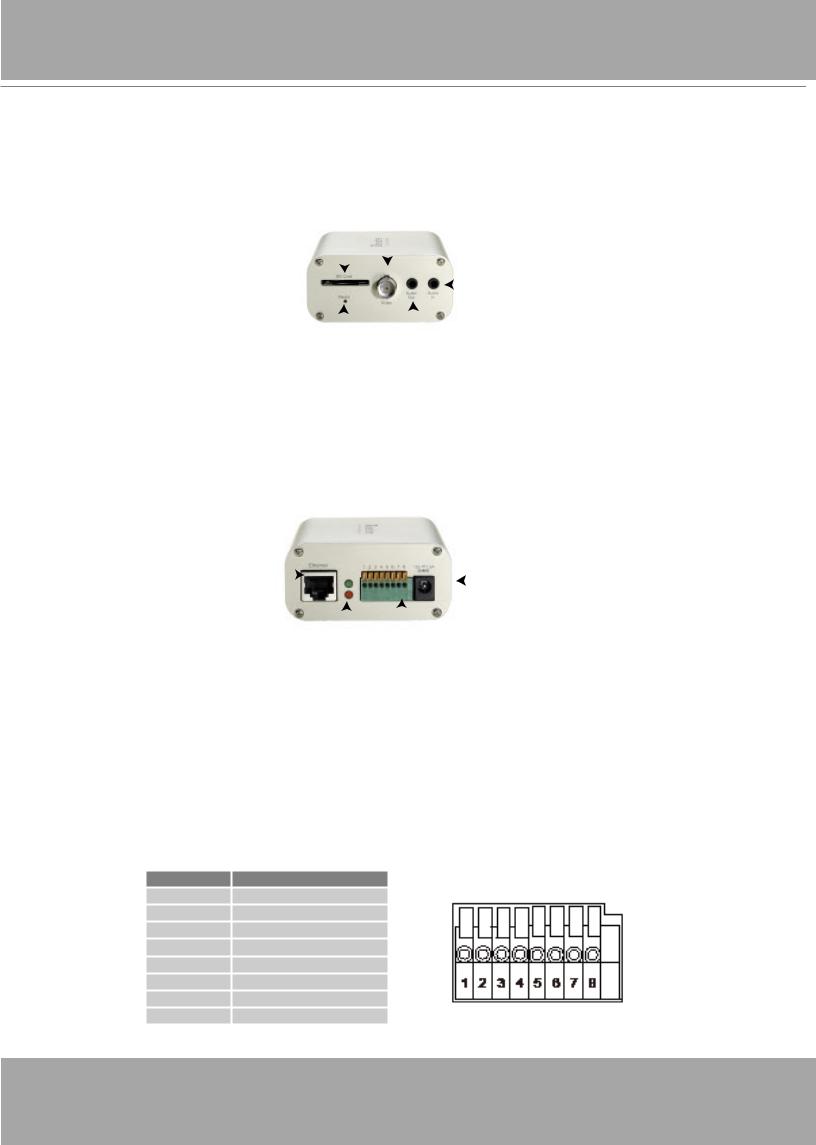
Physical Description
Front Panel
SD/SDHC Card Slot |
|
|
|
BNC Video Input |
|
|
|
|
|
|
|
|
|
||||
|
|
|
|
RCA Audio Input |
|
|
|
|
|
||
|
|
|
|
||
Recessed Reset |
|
|
|
|
|
|
|
||
RCA Audio Output |
||||
Button |
||||
Back Panel
Ethernet 10/100 |
|
|
|
|
|
|
Power Cord Socket |
|
|
|
|
|
|
||
RJ45 Socket |
|
|
|
|
|
|
|
|
|
|
|
|
|
|
|
|
|
|
|
|
|
General I/O Terminal Block |
|
|
|
|
|
|
|
||
|
|
Status LEDs |
|||||
|
|
|
|
||||
General I/O Terminal Block
This video server provides a general I/O terminal block which is used to connect external input / output devices. The pin definitions are described below.
Pin |
Name |
1Power +12V
2Digital output
3Digital input
4Ground
5AC 24V input
6AC 24V input
7RS-485 +
8RS-485 -
4 - User's Manual
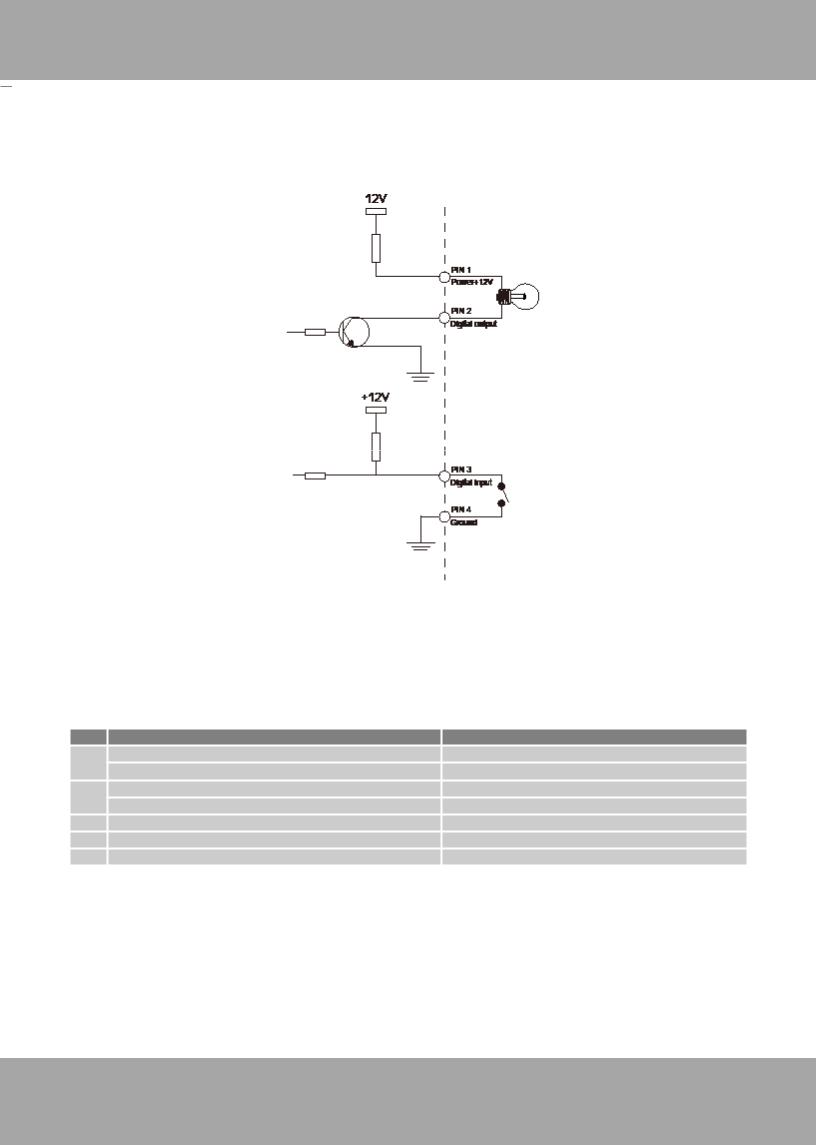
DI/DO Diagram
Please refer to the following illustration for the connection method.
Status LED
The LED indicates the status of the video server.
Item |
LED status |
Description |
|
1 |
Steady Red |
Power on and system booting |
|
Red LED unlighted |
Power off |
||
|
|||
2 |
Steady Red + Blink Green every 1 sec. |
Network works (heartbeat) |
|
Steady Red + Green LED unlighted |
Network fail |
||
|
|||
3 |
Steady Red + Blink Green every 2 sec. |
Audio mute (heartbeat) |
|
4 |
Blink Red every 0.15 sec. + Blink Green every 1 sec. |
Upgrading Firmware |
|
5 |
Blink Red every 0.15 sec. + Blink Green every 0.15 sec. Restore default |
||
User's Manual - 5

Hardware Reset
Recessed Reset Button
The reset button is used to reset the system or restore the factory default settings. Sometimes resetting the system can return the video server to normal operation. If the system problems remain after reset, restore the factory settings and install again.
Reset: Press and release the recessed reset button with a paper clip or thin object. Wait for the video server to reboot.
Restore: Press and hold the recessed reset button until the status LED rapidly blinks. It takes about 30 seconds. Note that all settings will be restored to factory default. Upon successful restore, the status LED will blink green and red during normal operation.
SD/SDHC Card Capacity
This video server is compliant with SD/SDHC 16GB / 8GB and other preceding standard SD cards.
6 - User's Manual
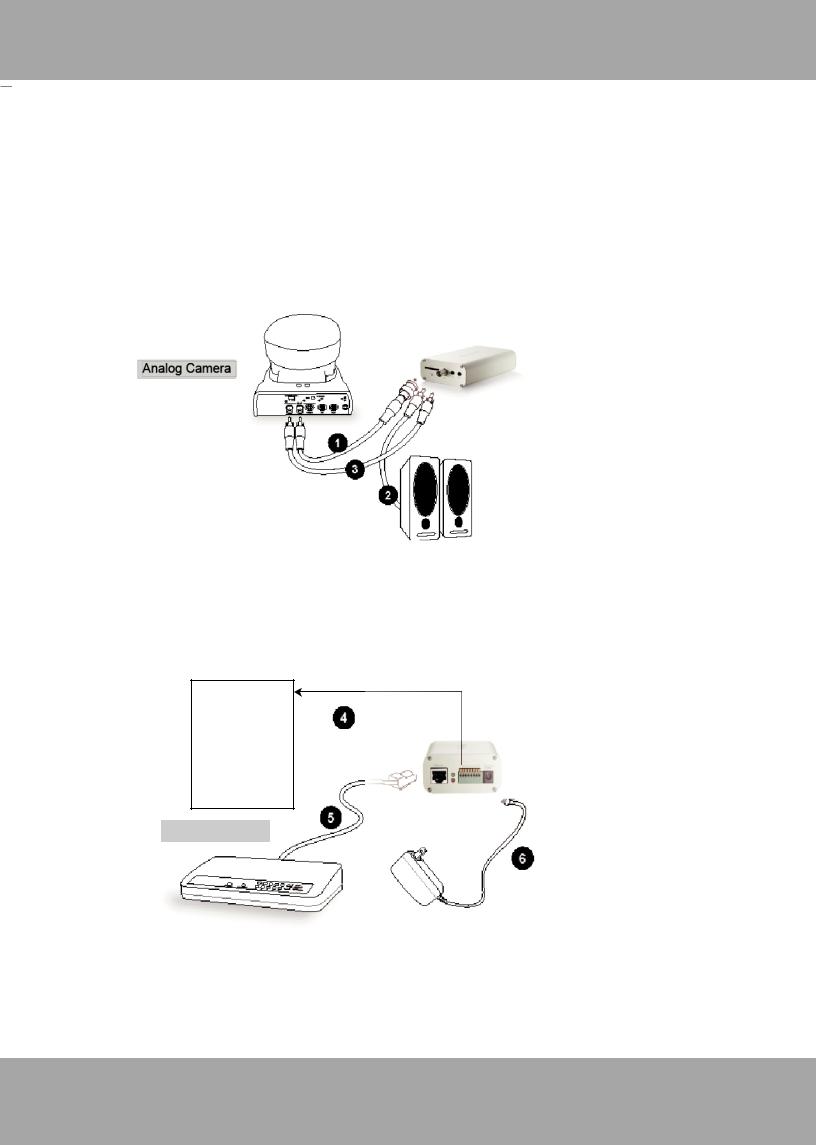
Network Deployment
Setting up the Video Server over the Internet
This section explains how to confi gure the video server to an Internet connection.
1.Make video connection from the camera to the BNC video input.
2.Make audio connection from the Line-Out audio source to the RCA audio input.
3.Make audio connection from RCA audio output to the speaker.
4.If you have external devices such as sensors and alarms, connect them to the general I/O terminal block.
5.Connect the video server to a switch via Ethernet cable.
6.Connect the power cable from the video server to a power outlet.
1: Power +12V
2:Digital output
3:Digital input
4:Ground
5:AC 24V
6:AC 24V
7:RS485+
8:RS485-
Ethernet Switch
There are several ways to set up the video server over the Internet. The fi rst way is to set up the video server behind a router. The second way is to utilize a static IP. The third way is to use PPPoE.
User's Manual - 7
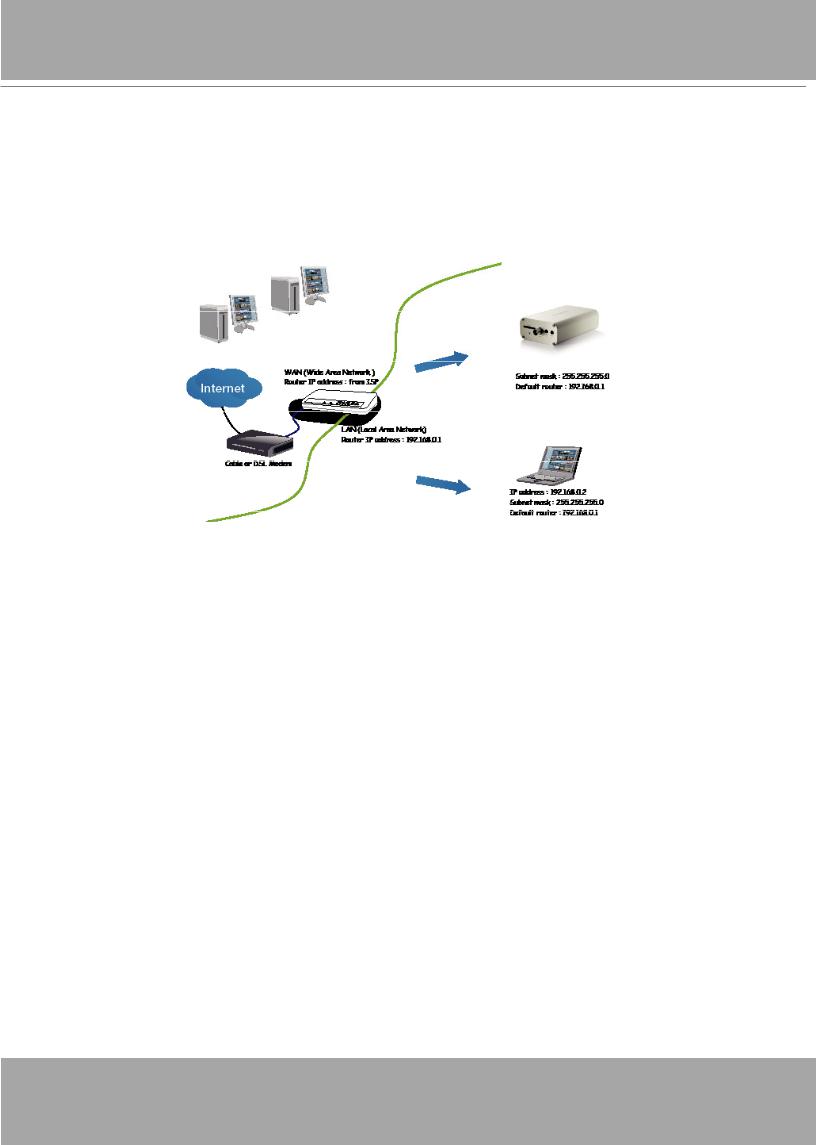
Internet connection via a router
Before setting up the video server over the Internet, make sure you have a router and follow the steps below.
1. Connect your video server behind a router, the Internet environment is illustrated below.
Regarding how to obtain your IP address, please refer to Software Installation on page 10 for details.
2.In this case, if the Local Area Network (LAN) IP address of your Video server is 192.168.0.3, please forward the following ports for the Video server on the router.
■HTTP port
■RTSP port
■RTP port for audio
■RTCP port for audio
■RTP port for video
■RTCP port for video
If you have changed the port numbers on the Network page, please open the ports accordingly on your router. For information on how to forward ports on the router, please refer to your router’s user’s manual.
3.Find out the public IP address of your router provided by your ISP (Internet Service Provider). Use the public IP and the secondary HTTP port to access the Video server from the
Internet. Please refer to Network Type on page 33 for details.
Internet connection with static IP
Choose this connection type if you are required to use a static IP for the Video server. Please refer to LAN on page 33 for details.
Internet connection via PPPoE (Point-to-Point over Ethernet)
Choose this connection type if you are connected to the Internet via a DSL Line. Please refer to PPPoE on page 34 for details.
8 - User's Manual
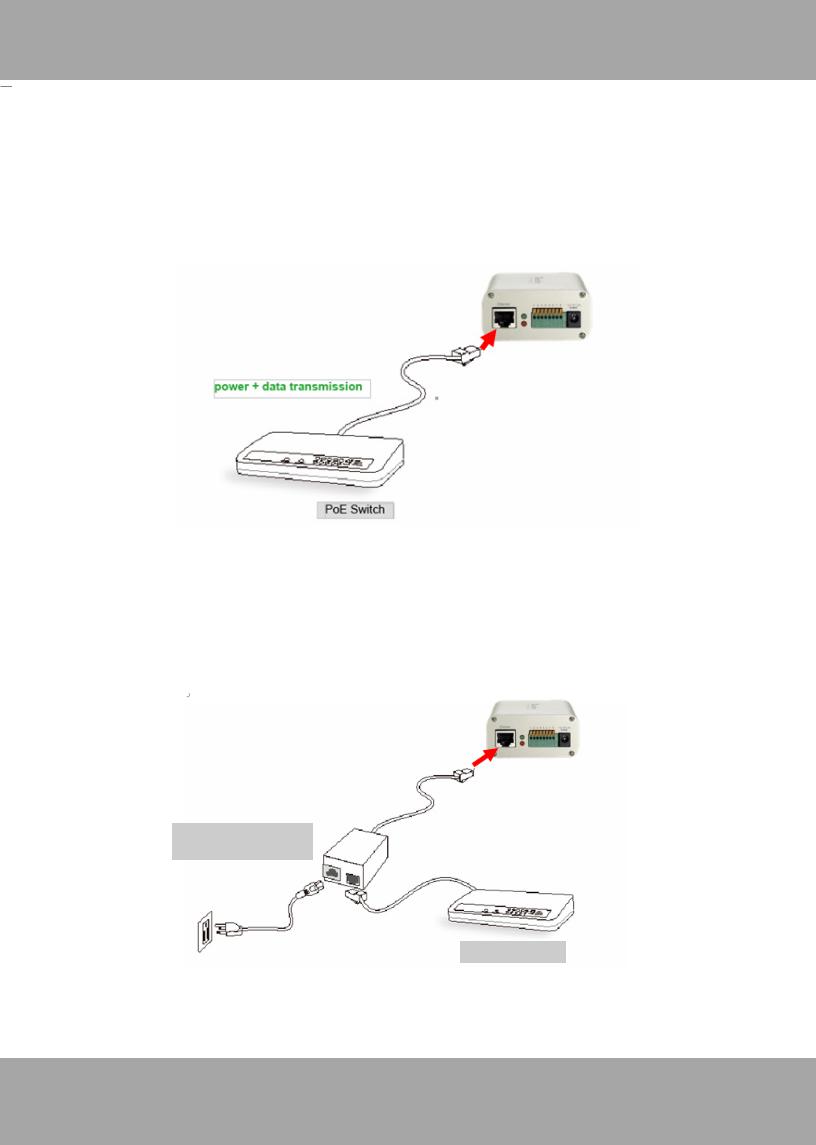
Set up the Video Server through Power over Ethernet (PoE)
When using a PoE-enabled switch
The video server is PoE-compliant, allowing transmission of power and data via a single
Ethernet cable. Follow the below illustration to connect the video server to a PoE-enabled switch via Ethernet cable.
When using a non-PoE switch
If your switch/router does not support PoE, use a PoE power injector (optional) to connect between the video server and a non-PoE switch.
PoE Power Injector
(optional)
Non-PoE Switch
User's Manual - 9
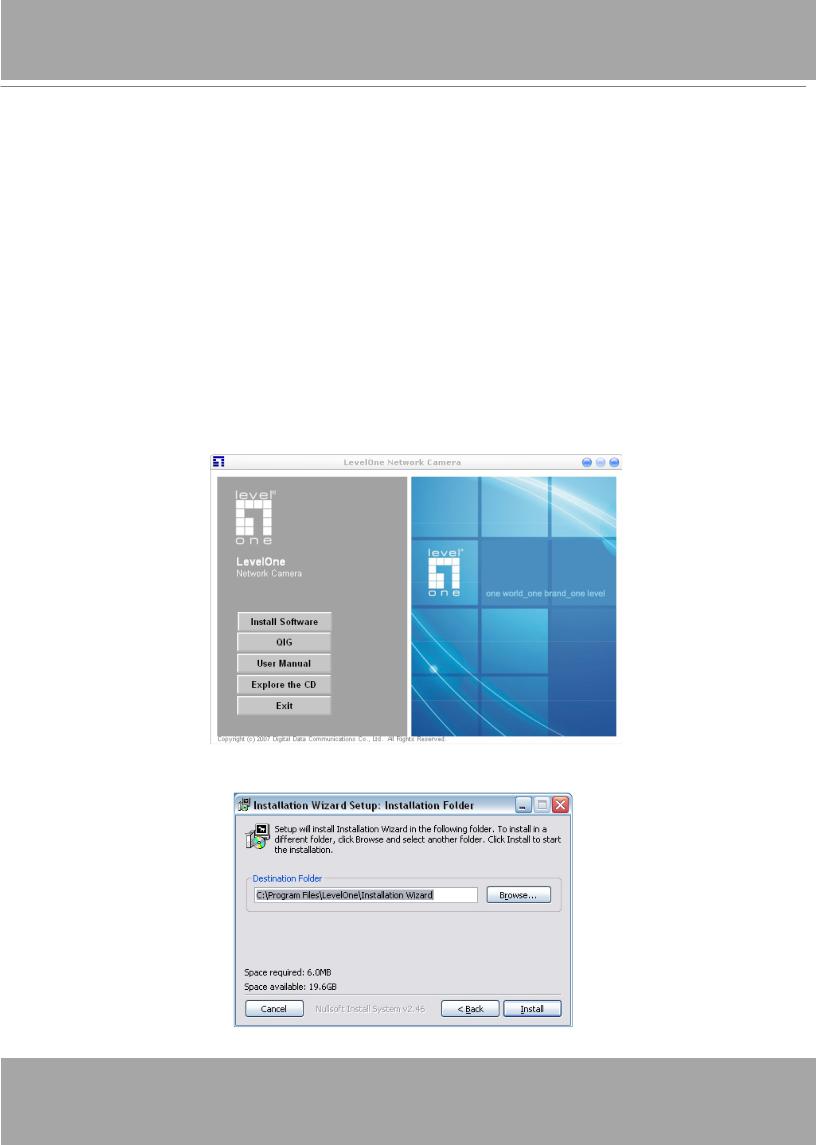
Software Installation
The following are steps for the software installation.
Note: The default user name is root and the password is blank How to Use Installation Wizard
Installation
The following are steps for the software installation.
STEP. 1 Put the Installation disk into the CD-ROM drive, and the installation should start automatically. If the installation does not start, click on “Start” on the lower left corner of your screen, open “My Computer” and double click on the CD-ROM icon. The Installation Wizard
Installation Window will appear.
STEP. 2 There are links on this page, including Install Software, User’s Manual and Customer
Homepage. Click on “Install Software” to enter Install Software page.
STEP. 3 There are links on this page, including Installation Wizard, User’s Manual and Surveillance Software. Click on “Installation Wizard” to launch the setup program.
Destination Location for Installation
10 - User's Manual
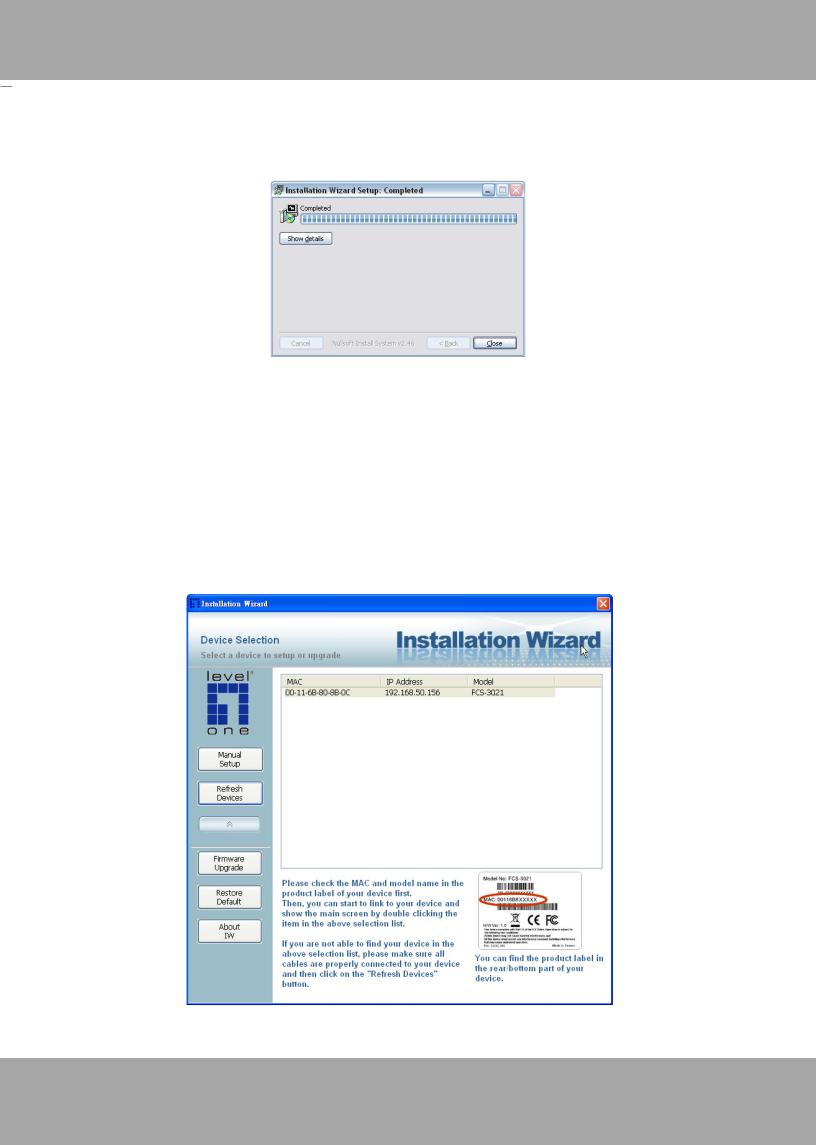
STEP 4: After clicking “Install” button, the install system will install the Installation Wizard to your computer, and a progress bar will display on the dialog. After completed the installation, please click on the “Close” button.
Completed
Using Installation Wizard
User Interface
Once you run the Installation Wizard, after a short searching time, you will see the user interface as below. “Manual Setup” button, a “Refresh Devices” button and an arrow button on the left panel of your user interface. When you click on the arrow button, you will see more advanced functional buttons: “Firmware Upgrade”, “Restore Default” and “About IW”. You can select your device by double-clicking it in the device list. The left three buttons (“Manual Setup”, “Firmware Upgrade”, and “Restore Default”) won’t be enabled until you select at least one device.
Installation Wizard allows you to setup one device at one time and upgrade multiple devices
(of the same model) at the same time. If you selected different models, then the “Firmware Upgrade” button would be disabled.
User's Manual - 11
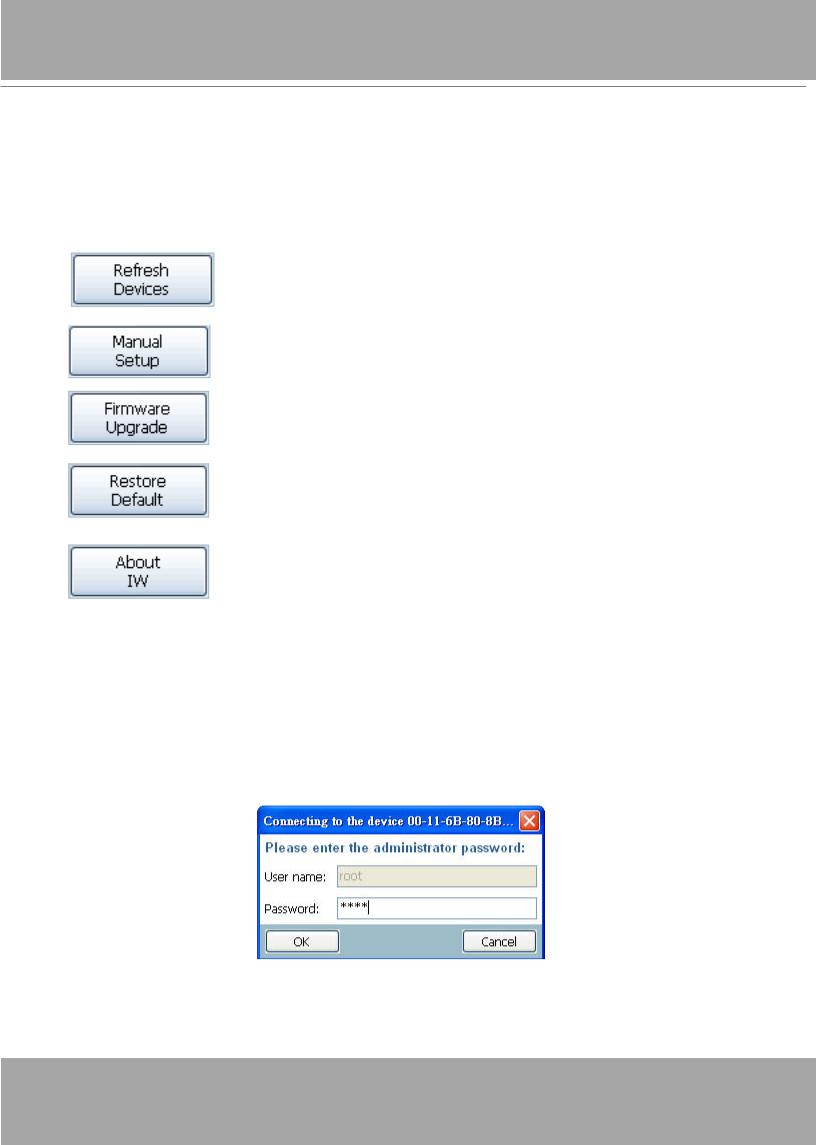
Installation wizard allows you to setup or upgrade multiple devices (of the same model) at the same time. If you selected different models, then the buttons will be disabled. There are five buttons on the bottom of the main page, and five buttons on the left panel of the main page.
Buttons
Click on this button to clean up the device list and search all devices on the within the same subnet again. It will take about 5 seconds.
Click on this button to modify the settings of the selected devices. For more detail, please refer to 0 Setup.
Click on this button to upgrade the firmware of the selected devices. For more detail, please refer to 0 Upgrade.
Click on this button to reset the selected devices to default settings.
Click on this button to get information about the Installation Wizard.
Manual Setup
When you select one device in the selection list, the “Manual Setup” button will be enabled. Click on it to modify the settings of the selected device. After clicked on the “Manual Setup” button, Installation Wizard would try to connect to the selected device.
The default Administrator’s password is blank and the Network Camera initially will not ask for any password. If the authentication is failed, there would be a pop-up dialog window to ask for correct password. If you failed three times, the Installation Wizard would show you a warning dialog window and abort the connecting to the selected device.
Authentication Dialog Window
12 - User's Manual
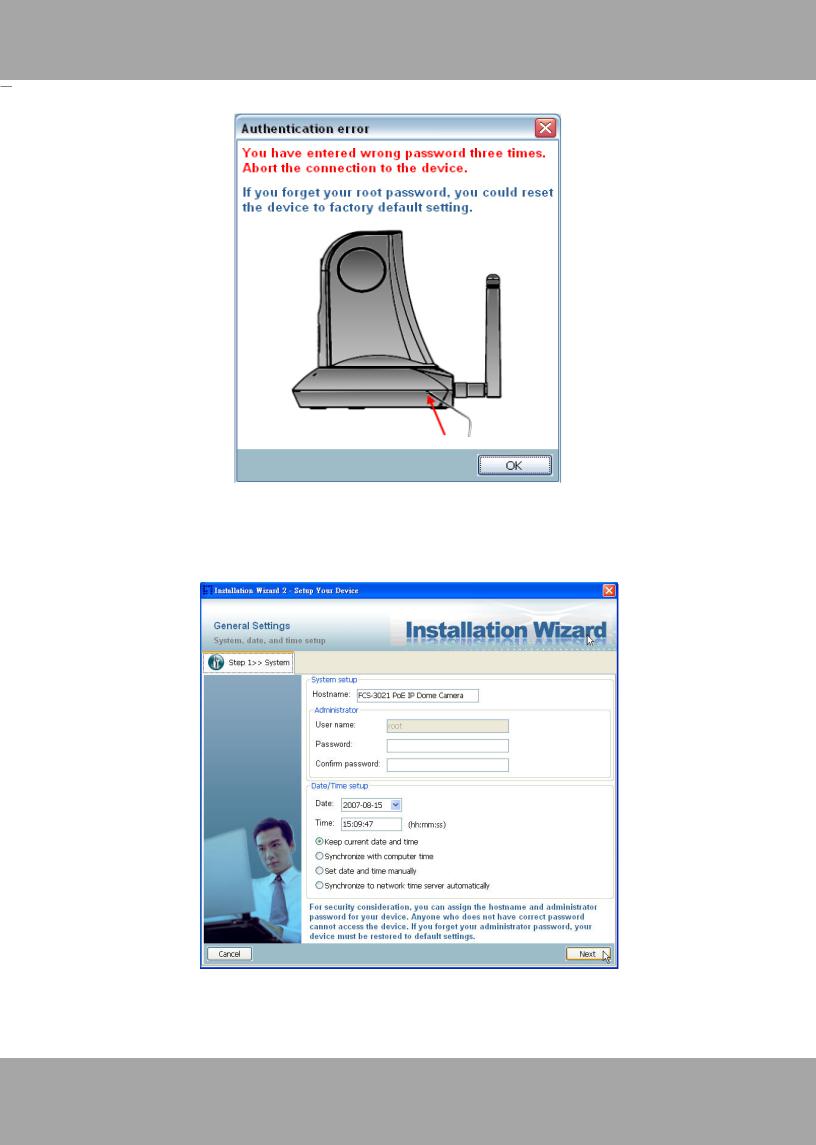
Authentication error
System Setting
After connected to the selected device, the Installation Wizard will switch to system setting page as below.
System setting page
User's Manual - 13
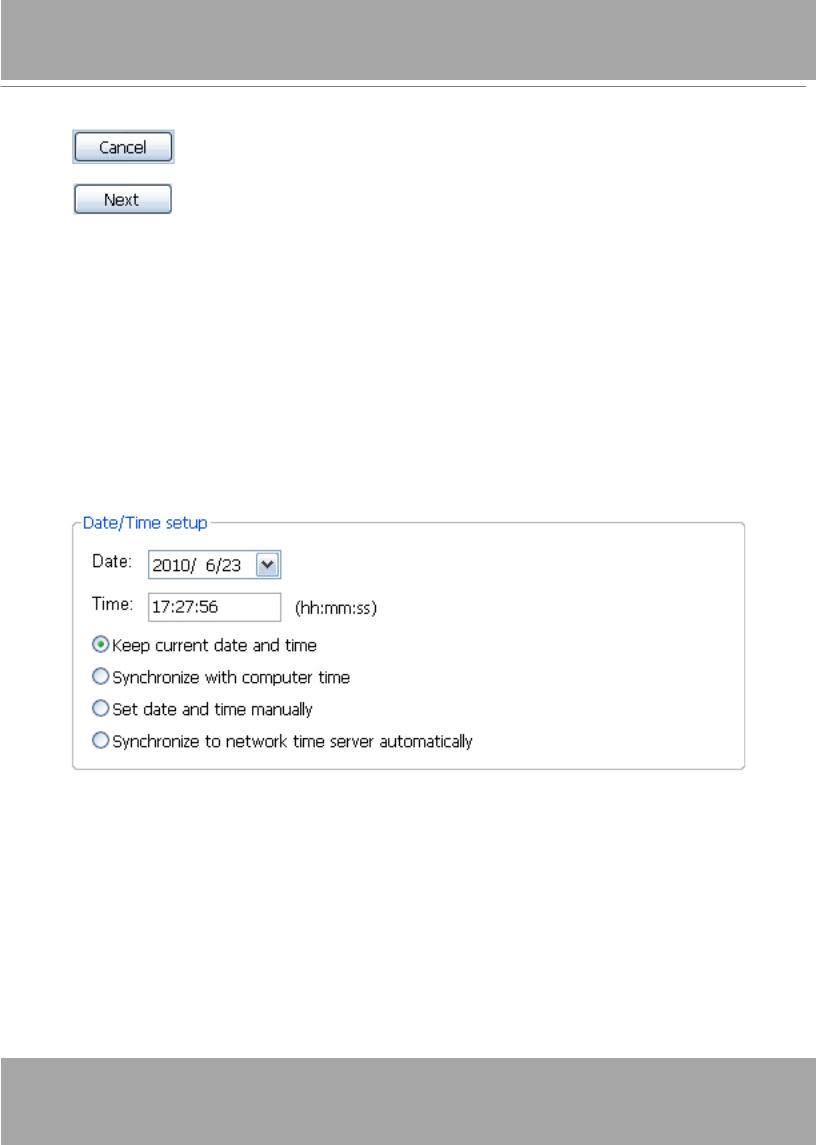
Click on this button to cancel the setup progress.
Click on this button to keep the present setting and go to the next page.
Change Host Name
The “Hostname” is used for the homepage title of main page and is displayed as the title in the video window of the main page. The maximum string length is 40 characters or 20 characters in double-byte-character-systems like Chinese or Japanese. But for some models supported
Unicode, the maximum string length depends on the characters you input, and it may less than
20 characters.
Change root password
To change the administrator’s password, type the new password in both “Password” and
“Confirm Password” text boxes identically. What is typed will be displayed as asterisks for security purposes. The maximum password depends on the server you connected.
Adjust date and time
Date/Time setup
There are three ways to adjust system date and time:
1.“Synchronize with computer time”: The easiest way is to make device synchronized with your computer time.
2.“Set date and time manually”: Set the date and time manually by entering new values.
Notice the format in the related field while typing.
3.“Synchronize to network time server automatically”: Make device automatically synchronize with timeservers over the Internet every hour.
If you want to keep the current date and time, please choose “Keep current date and time”.
14 - User's Manual
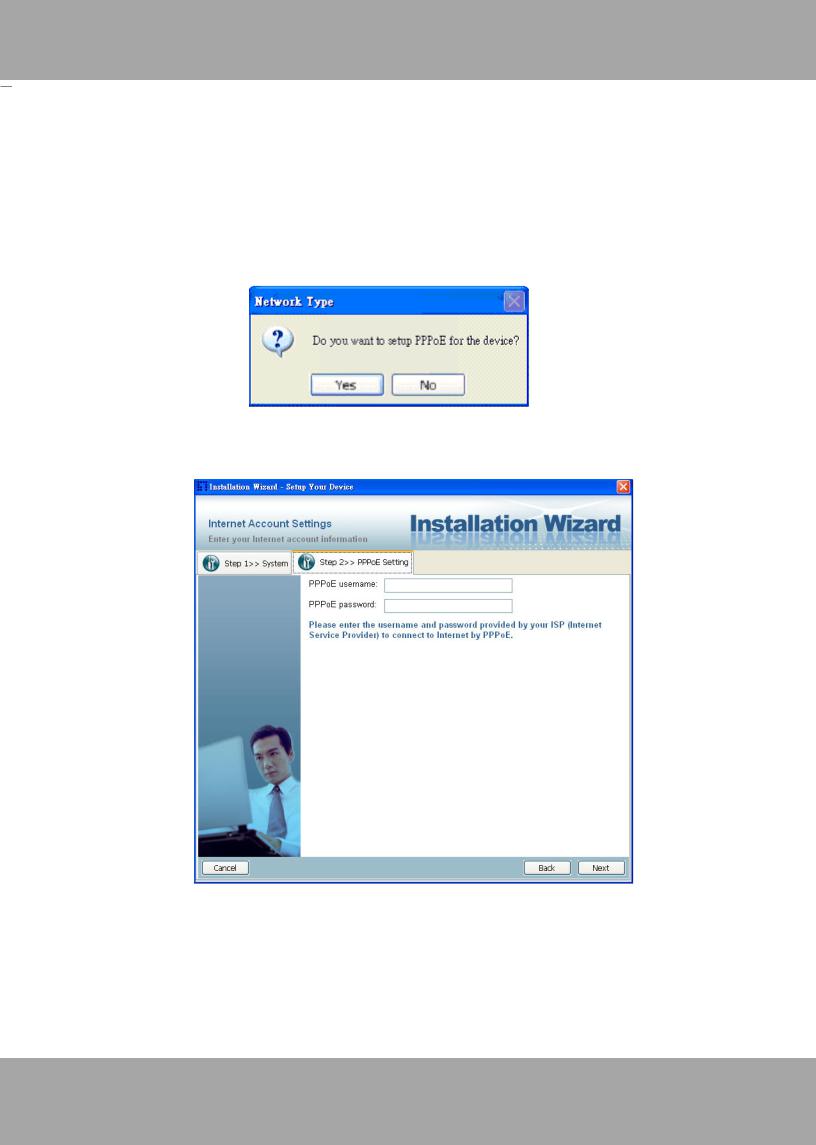
Network Setting
The Installation Wizard can help you to setup the network connection with LAN or PPPoE. After you clicked on the “Next” button on the System page, the Installation Wizard would lead you to the PPPoE setting page. If you want to connect your server to Internet via PPPoE, please click on “Yes” to start the PPPoE setting process, or click on “No” to invoke the LAN setting.
Choosing the network type
PPPoE Setting
Network setting for PPPoE
If you click on “Yes” in the “Network Type” dialog window, you will be led to the PPPoE setting page. In this page, you can input the “PPPoE username” and “PPPoE password” provided by your ISP, and then the server will be set to PPPoE mode rather than LAN mode when the setup is completed. If you don’t know the account information, please contact your ISP. After inputting the account information, please click on the “Next” button to continue your next step.
User's Manual - 15

LAN Setting
If you click on “No” in the “Network Type” dialog window, you will be led to the Network setting page. In this page, you can change the server’s IP address, subnet mask, default gateway, primary DNS server, secondary DNS and DHCP server. Please refer to the below page.
Network Setting for LAN
You could set up the network with DHCP or fixed IP:
1.DHCP: Check the “Get IP by DHCP Server automatically” will force the device to renew its
IP address whenever it reboots, and the related network configuration is provided by the DHCP server.
2.Fixed IP: If you want the device to use a fixed IP, please uncheck the “Get IP by DHCP Server automatically” checkbox and assign a valid IP address, subnet mask, default gateway and DNS server for the device.
Mobile Access
After finished the DDNS setting and click on the Next button. If your device supports mobile viewer and you want to access the device by mobile phone, you can enable the “Mobile Access” by clicking on the Yes button. The Installation Wizard will do some setting for mobile viewing toward the device:
1.Video: The video codec will be set to MPEG-4, and the resolution will be set to 176x144 pixels.
2.Audio: The audio codec will be set to AAC.
16 - User's Manual
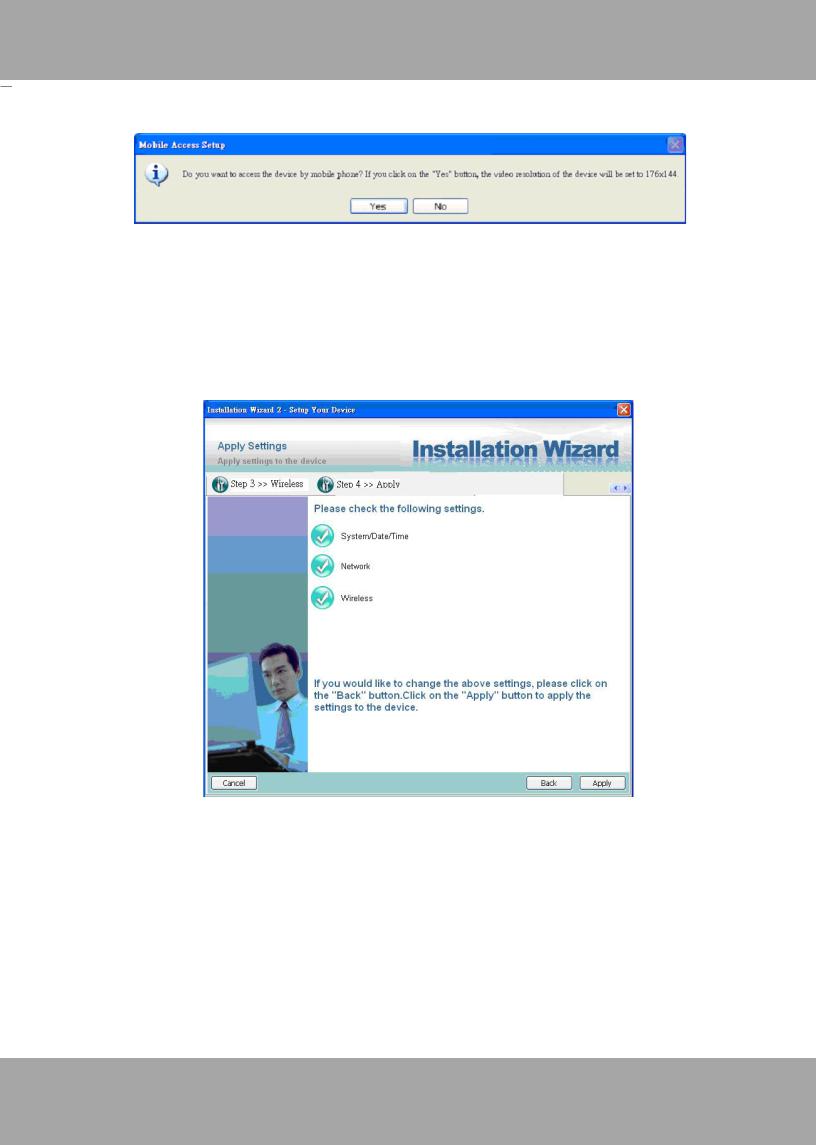
Mobile Access
Apply to selected device
After configuring all the settings, the apply page will show up. Click on “Apply” button to apply the changes to the selected device or click on “Back” button to go back to the previous page and modify the setting again.
Apply page
When you click on the “Apply”, it will start to update your settings to server.
Upgrade
When you select one device or multiple devices (of the same model), the “Firmware Upgrade” button will be enabled. Click on it to upgrade the firmware of the selected device(s). After click on the “Firmware Upgrade” button, Installation Wizard will try to connect the selected device(s) and lead you to the firmware upgrade page.
User's Manual - 17
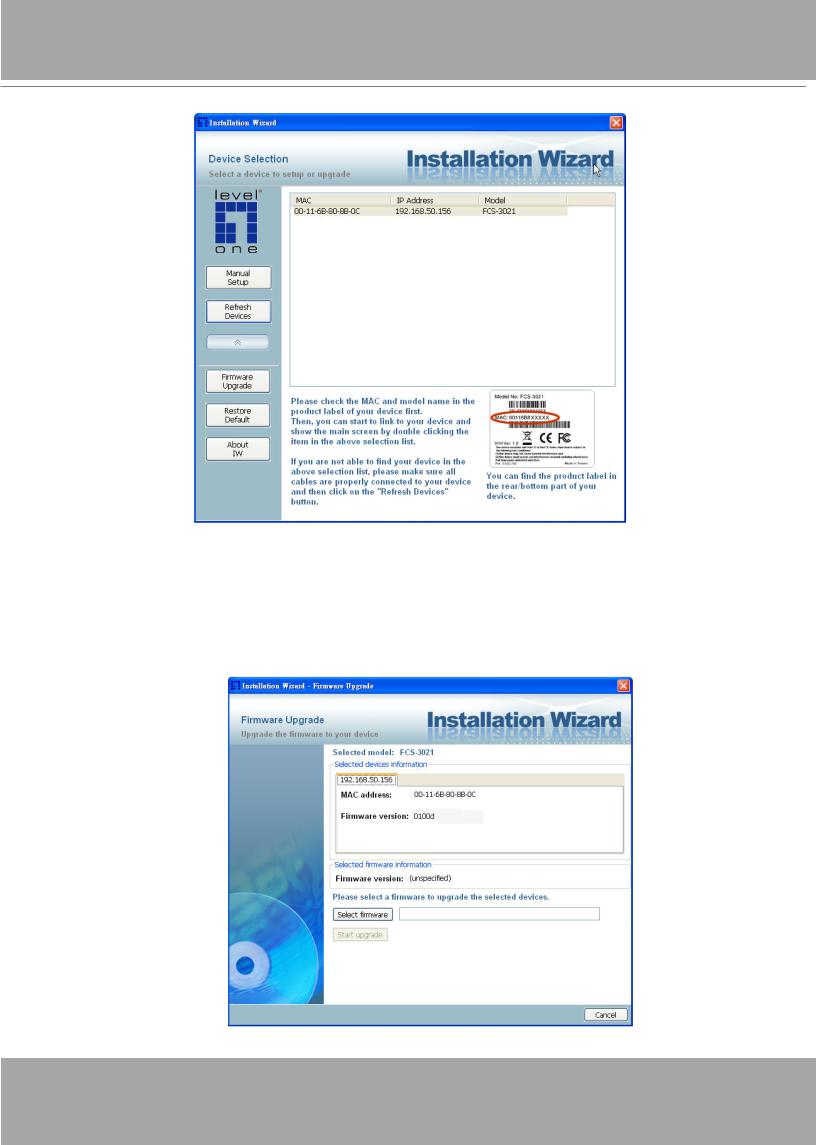
Click on the “Firmware Upgrade”
Device Information
After connected to the selected device(s), it would display as below. If you select more than one device, then the device information will show all the selected devices. You can switch to the server info by click on the tab control.
Device information
18 - User's Manual
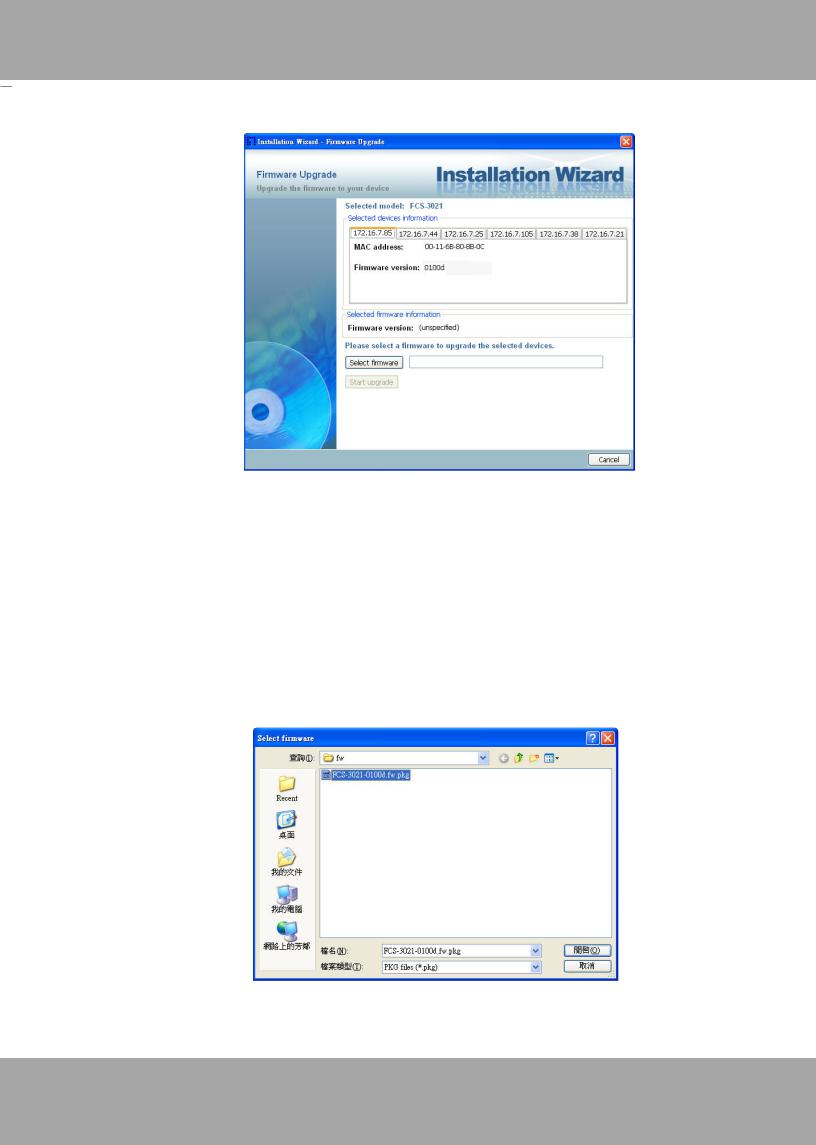
Multiple devices information
Firmware Information
The selected firmware information will show the information about the file that you selected. Firmware version: The version number of the selected firmware.
Select Firmware
You can use the “Select firmware” button to browse the file that you want upgrade onto the selected device(s). After selected the file, Installation Wizard will check whether the file you selected is correct. If it’s the correct version, then the package information will display the information about the file and enable the “Start Upgrade” button. Therefore you can click on the button to upgrade the firmware. If not, then it will be a pop-up warning message.
Select firmware
User's Manual - 19
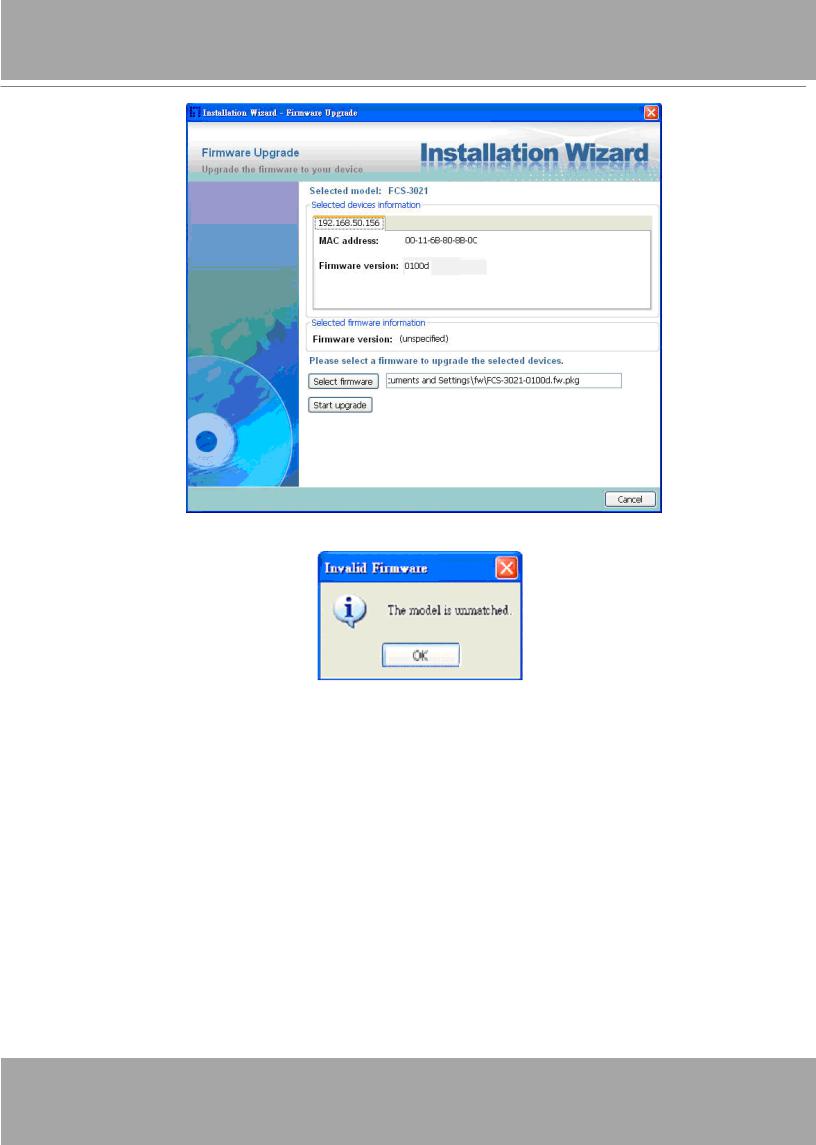
Firmware Information
Warning message for unmatched firmware
20 - User's Manual
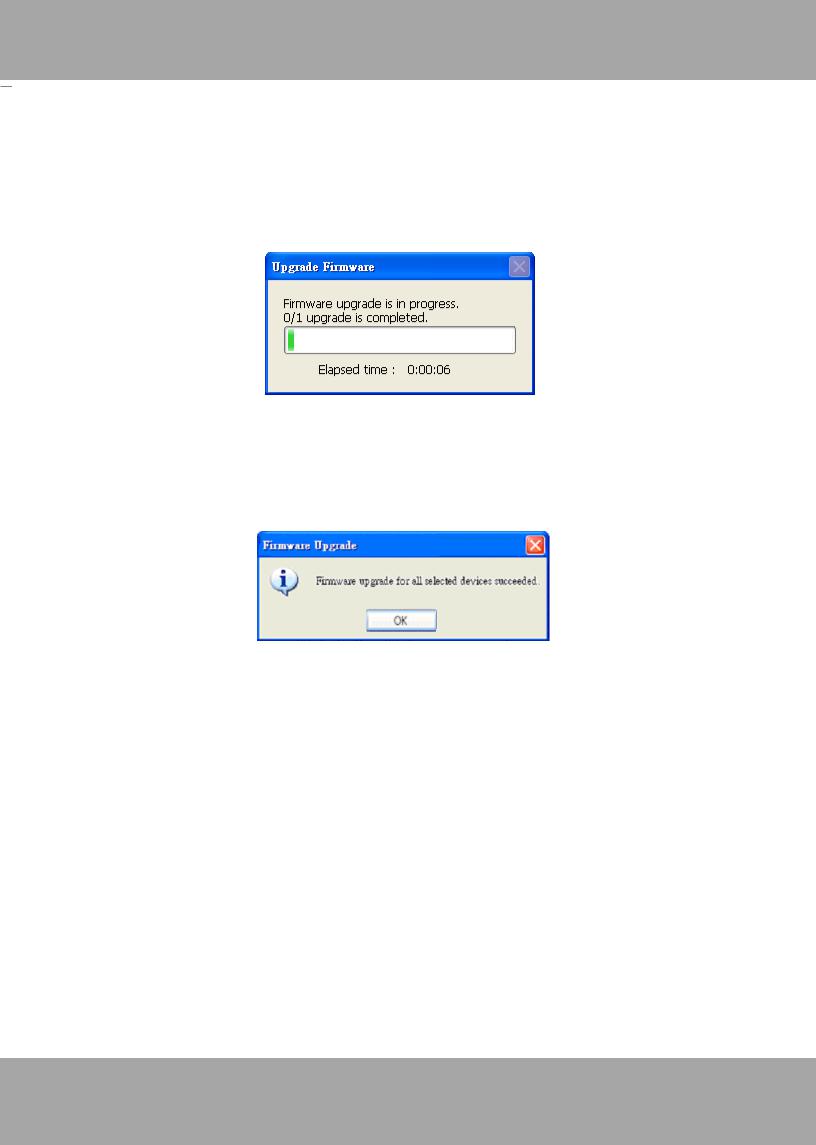
Start Upgrade
Clicking on the “Start Upgrade” button to upgrade the firmware of the selected device(s), and it will be a pop-up dialog window to show the progress of the upgrading process. Usually, it will take about 5 to 10 minutes to finish the firmware upgrading. It depends on your server model and network bandwidth. We recommend you do the upgrade process in wired LAN environment rather than PPPoE or wireless environment.
Update progress
After the upgrade process had been done, you could see the dialog window as below.
Please click on the button “OK” to finish it.
Upgrade Done
User's Manual - 21
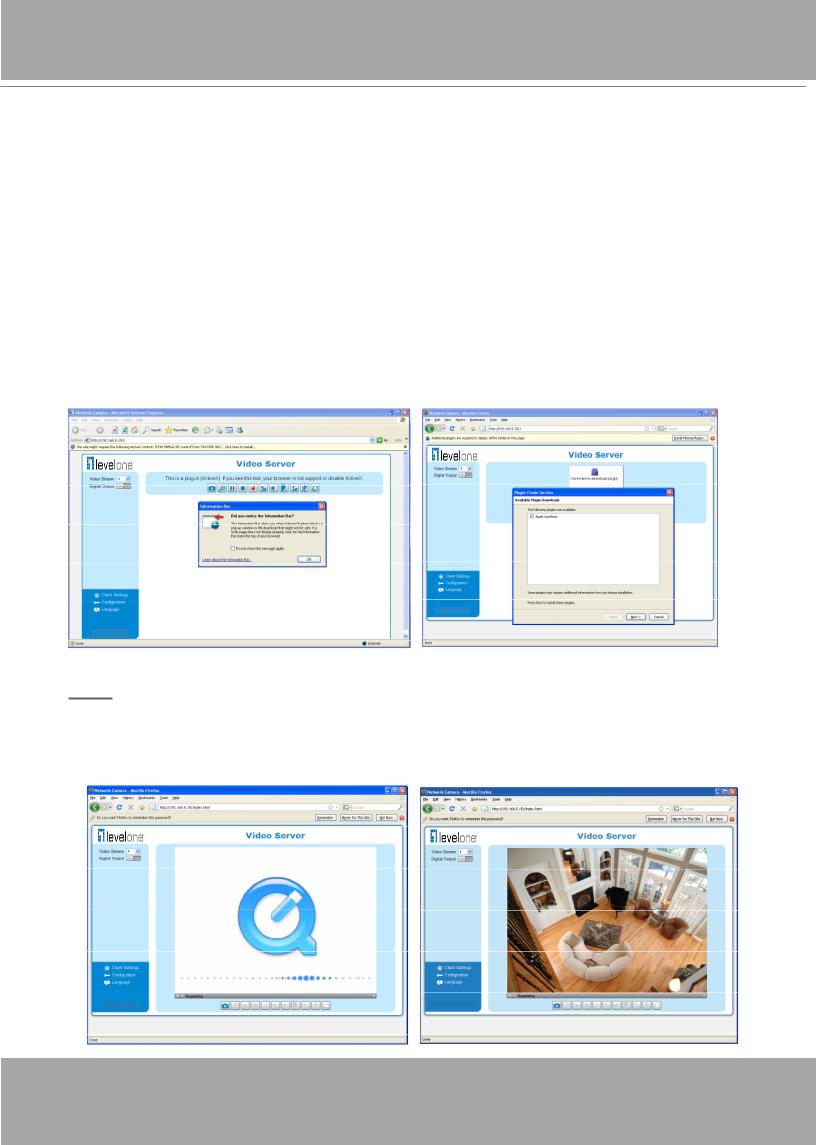
Accessing the Video Server
This chapter explains how to access the video server through web browsers, RTSP players,
3GPP-compatible mobile devices, and LevelOne recording software.
Using Web Browsers
Use Installation Wizard 2 (IW2) to access to the video servers on the LAN.
If your network environment is not a LAN, follow these steps to access the Netwotk Camera:
1.Launch your web browser (ex. Microsoft® Internet Explorer, Mozilla Firefox, or Netscape).
2.Enter the IP address of the video server in the address field. Press Enter.
3.The live video will be displayed in your web browser.
4.If it is the first time installing the LevelOne video server, an information bar will pop up as shown below. Follow the instructions to install the required plug-in on your computer.
NOTE
► For Mozilla Firefox or Netscape users, your browser will use Quick Time to stream the live video. If you donn’t have Quick Time on your computer, please download it first, then launch the web browser.
22 - User's Manual

►By default, the video server is not password-protected. To prevent unauthorized access, it is highly recommended to set a password for the video server.
For more information about how to enable password protection, please refer to Security on page 26.
►If you see a dialog box indicating that your security settings prohibit running ActiveX®
Controls, please enable the ActiveX® Controls for your browser.
1. Choose Tools > Internet Options > Security > Custom Level.
2. Look for Download signed ActiveX® controls; select Enable or Prompt. Click OK.
3. Refresh your web browser, then install the Active X® control. Follow the instructions to complete installation.
User's Manual - 23
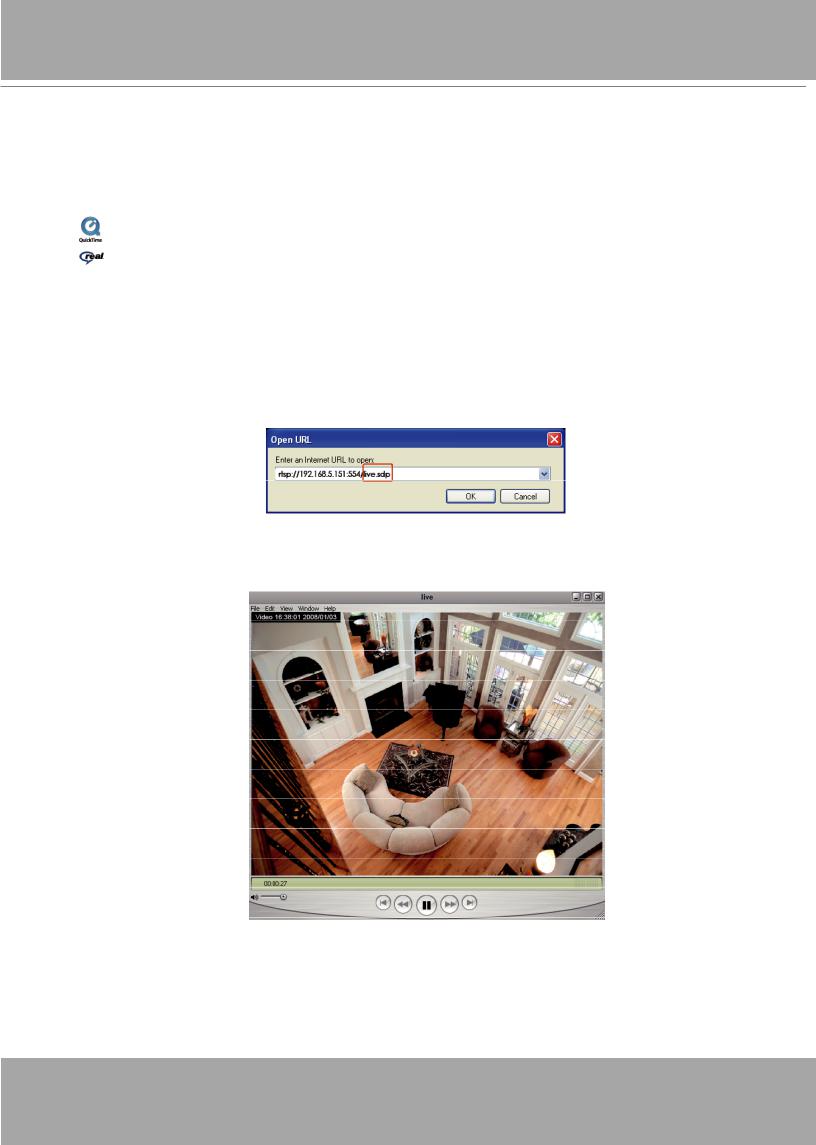
Using RTSP Players
To view the MPEG-4 streaming media using RTSP players, you can use one of the following players that support RTSP streaming.
Quick Time Player
Real Player
VLC media player 1. Launch the RTSP player.
2. ChoosempegableFile > OpenPlayerURL. A URL dialog box will pop up.
3. The address format is rtsp://<ip address>:<rtsp port>/<RTSP streaming access name for pvPlayer
stream1 or stream2>
As most ISPs and players only allow RTSP streaming through port number 554, please set the
RTSP port to 554. For more information, please refer to RTSP Streaming on page 46.
For example:
4. The live video will be displayed in your player.
For more information on how to configure the RTSP access name, please refer to RTSP
Streaming on page 46 for details.
24 - User's Manual
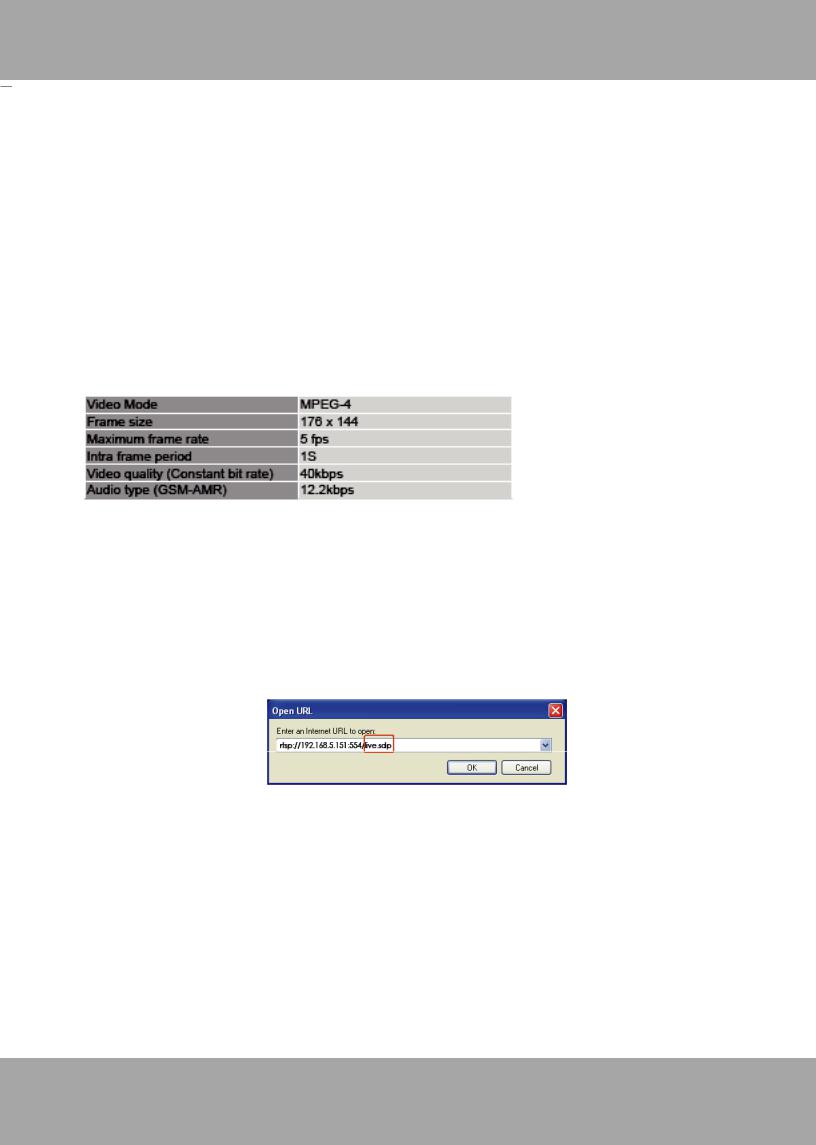
Using 3GPP-compatible Mobile Devices
To view the streaming media through 3GPP-compatible mobile devices, make sure the video server can be accessed over the Internet. For more information on how to set up the video server over the Internet, please refer to Setup the video server over the Internet on page 7.
To utilize this feature, please check the following settings on your video server:
1.Because most players on 3GPP mobile phones do not support RTSP authentication, make sure the authentication mode of RTSP streaming is set to disable.
For more information, please refer to RTSP Streaming on page 46.
2.As the the bandwidth on 3G networks is limited, you will not be able to use a large video size.
Please set the video and audio streaming parameters as listed below.
3.As most ISPs and players only allow RTSP streaming through port number 554, please set the RTSP port to 554. For more information, please refer to RTSP Streaming on page 46.
4.Launch the player on the 3GPP-compatible mobile devices (ex. Real Player).
5.Type the following URL commands into the player.
The address format is rtsp://<public ip address of your camera>:<rtsp port>/<RTSP streaming access name for stream 3>.
For example:
User's Manual - 25
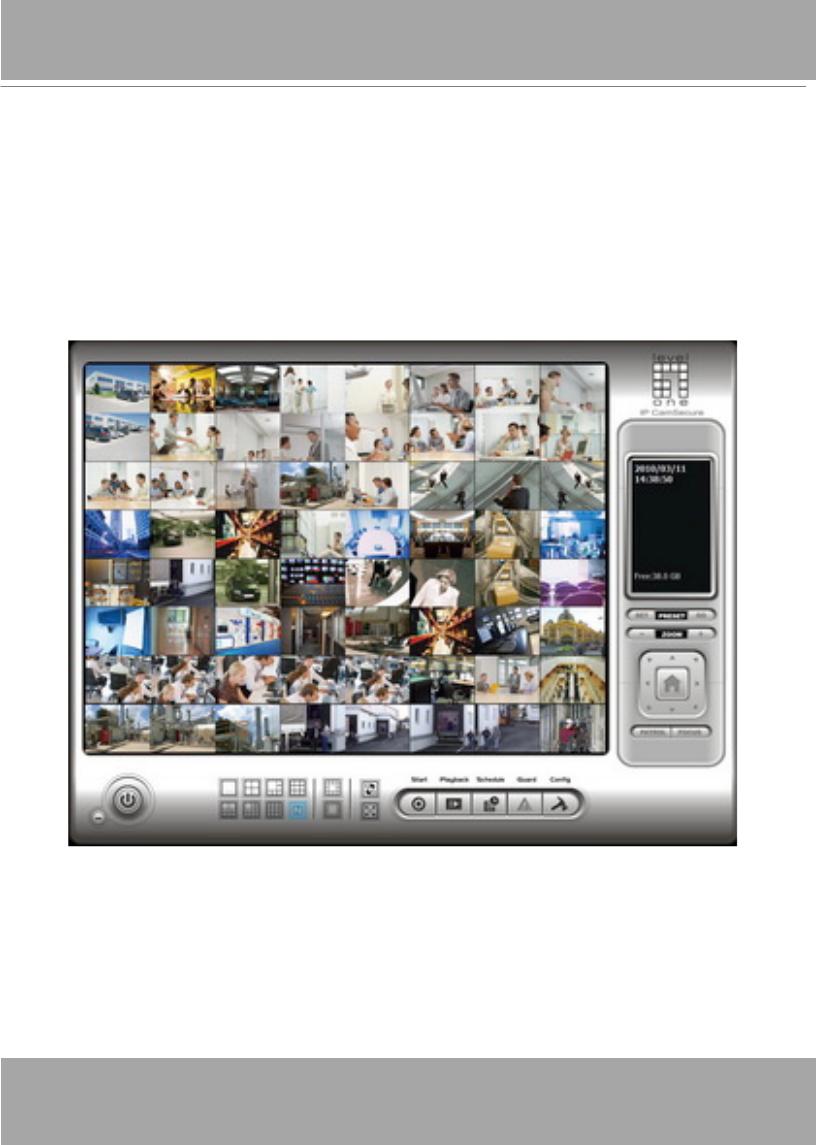
Using LevelOne Recording Software
The product software CD also contains recording software, allowing simultaneous monitoring and video recording for multiple video servers. Please install the recording software; then launch the program to add the video server to the Channel list. For detailed information about how to use the recording software, please refer to the user’s manual of the software or download it from http://www.LevelOne.com.
26 - User's Manual
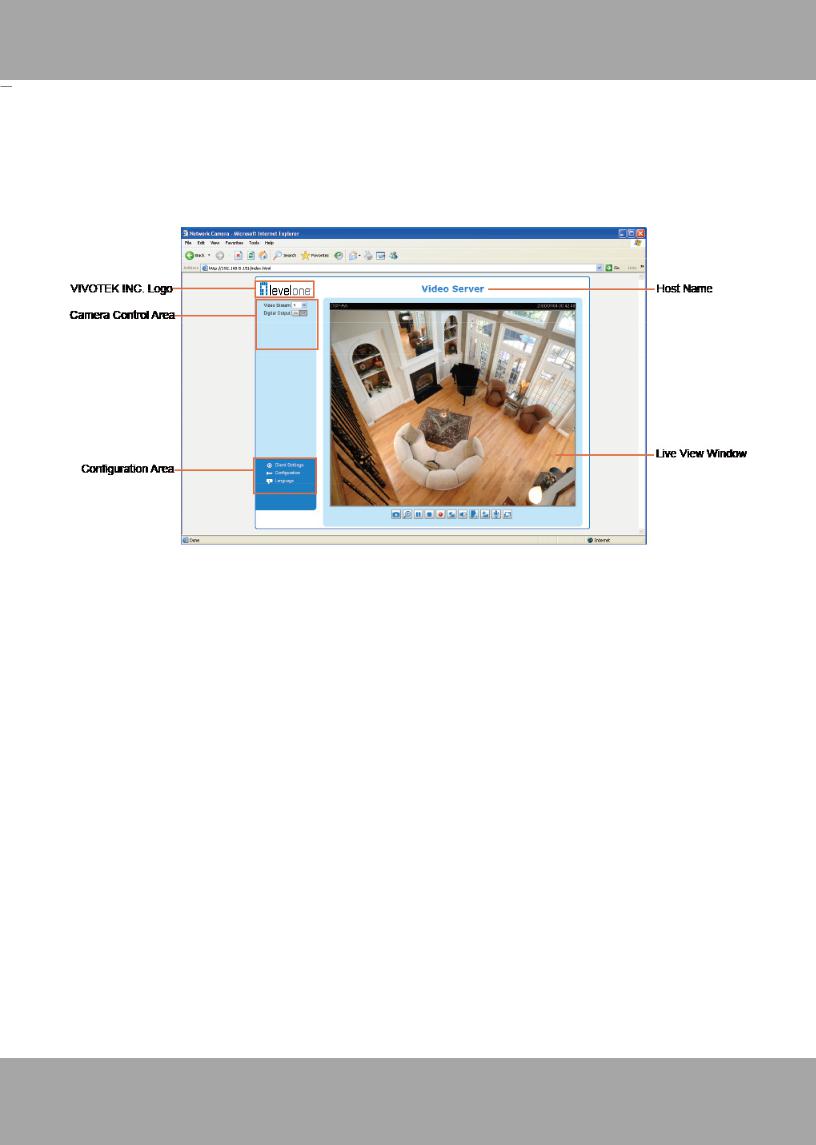
Main Page
This chapter explains the layout of the main page. It is composed of the following sections:
LevelOne INC. Logo, Host Name, Camera Control Area, Configuration Area, Menu, and Live
Video Window.
LevelOne INC. Logo
Click this logo to visit the LevelOne website.
Host Name
The host name can be customized to fit your needs. For more information, please refer to System on page 24.
Camera Control Area
Video Stream: This video server supports multiple streams (stream 1 ~ 4) simultaneously. You can select either one for live viewing. For more information about multiple streams, please refer to page 56 for detailed information.
Digital Output: Click to turn the digital output device on or off.
Configuration Area
Client Settings: Click this button to access the client setting page. For more information, please refer to Client Settings on page 21.
Configuration: Click this button to access the configuration page of the video server. It is suggested that a password be applied to the video server so that only the administrator can configure the video server. For more information, please refer to Configuration on page 23.
Language: Click this button to choose a language for the user interface. Language options are available in: English, Deutsch, Español, Français, Italiano, , Português, , and .
User's Manual - 27

Live Video Window
■ The following window is displayed when the video mode is set to MPEG-4:
Video Title: The video title can be confi gured. For more information, please refer to Video Settings on page 53.
MPEG-4 Protocol and Media Options: The transmission protocol and media options for MPEG-4 video streaming. For further confi guration, please refer to Client Settings on page 21.
Time: Display the current time. For further confi guration, please refer to Video Settings on page 53.
Title and Time: The video title and time can be stamped on the streaming video. For further confi guration, please refer to Video Settings on page 53.
Video and Audio Control Buttons: Depending on the video server model and video server confi guration, some buttons may not be available.
Snapshot: Click this button to capture and save still images. The captured images will be displayed in a pop-up window. Right-click the image and choose Save Picture As to save it in JPEG (*.jpg) or BMP
(*.bmp) format.
Digital Zoom: Click and uncheck “Disable digital zoom” to enable the zoom operation. The navigation screen indicates the part of the image being magnifi ed. To control the zoom level, drag the slider bar. To
move to a different area you want to magnify, drag the navigation screen.
Pause: Pause the transmission of the streaming media. The button becomes the |
Resume button |
|
after clicking the Pause button. |
|
|
Stop: Stop the transmission of the streaming media. Click the |
Resume button to continue |
|
transmission. |
|
|
Start MP4 Recording: Click this button to record video clips in MP4 file format to your computer.
Press the |
Stop MP4 Recording button to end recording. When you exit the web browser, video |
recording stops accordingly. To specify the storage destination and fi le name, please refer to MP4 Saving Options on page 22 for details.
28 - User's Manual
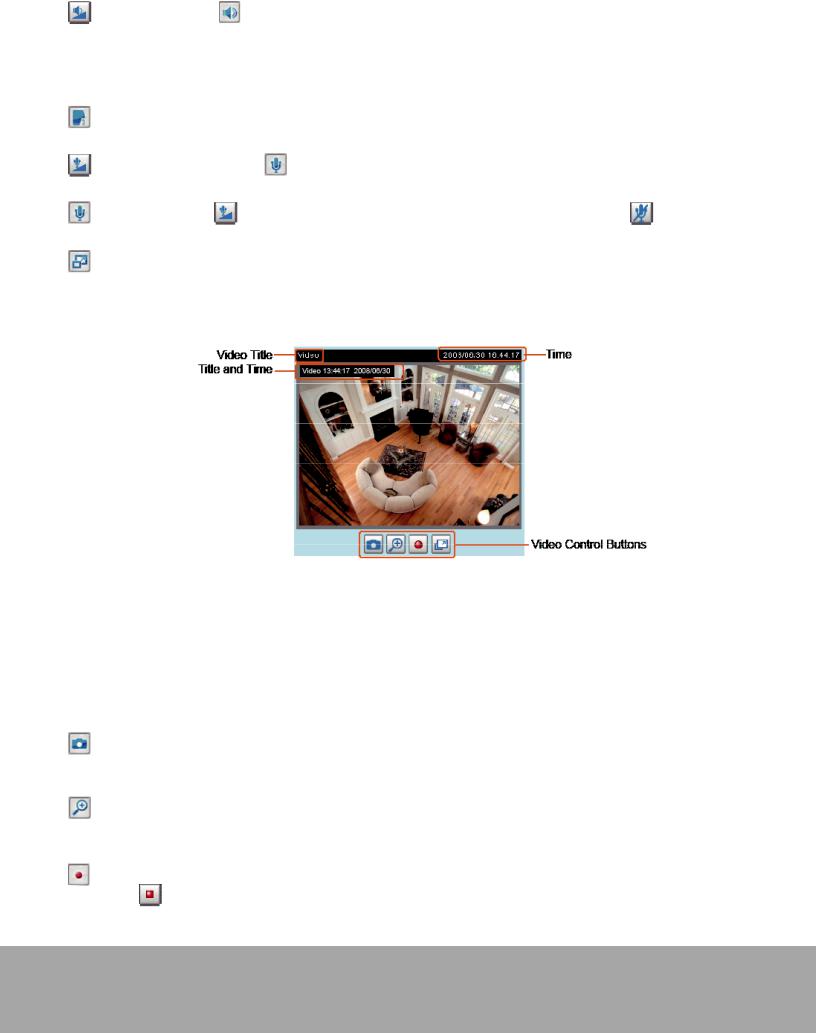
|
|
|
|
Volume: When the |
Mute function is not activated, move the slider bar to adjust the volume on the |
local computer. |
|
 Mute: Turn off the volume on the local computer. The button becomes the
Mute: Turn off the volume on the local computer. The button becomes the  Audio On button after clicking the Mute button.
Audio On button after clicking the Mute button.
Talk: Click this button to talk to people around the video server. Audio will project from the external speaker connected to the video server. Click this button  again to end talking transmission.
again to end talking transmission.
Mic Volume: When the |
Mute function is not activated, move the slider bar to adjust the |
||
microphone volume on the local computer. |
|
||
Mute: Turn off the |
Mic volume on the local computer. The button becomes the |
Mic On button |
|
after clicking the Mute button. |
|
|
|
Full Screen: Click this button to switch to full screen mode. Press the “Esc” key to switch back to normal mode.
■ The following window is displayed when the video mode is set to MJPEG:
Video Title: The video title can be confi gured. For more information, please refer to Video Settings on page 53.
Time: Display the current time. For more information, please refer to Video Settings on page 53.
Title and Time: Video title and time can be stamped on the streaming video. For more information, please refer to Video Settings on page 53.
Video and Audio Control Buttons: Depending on the video server model and video server confi guration, some buttons may not be available.
Snapshot: Click this button to capture and save still images. The captured images will be displayed in a pop-up window. Right-click the image and choose Save Picture As to save it in JPEG (*.jpg) or BMP
(*.bmp) format.
Digital Zoom: Click and uncheck “Disable digital zoom” to enable the zoom operation. The navigation screen indicates the part of the image being magnifi ed. To control the zoom level, drag the slider bar. To
move to a different area you want to magnify, drag the navigation screen.
Start MP4 Recording: Click this button to record video clips in MP4 file format to your computer.
Press the |
Stop MP4 Recording button to end recording. When you exit the web browser, video |
recording stops accordingly. To specify the storage destination and fi le name, please refer to MP4 Saving Options on page 22 for details.
User's Manual - 29

Full Screen: Click this button to switch to full screen mode. Press the “Esc” key to switch back to normal mode.
30 - User's Manual
